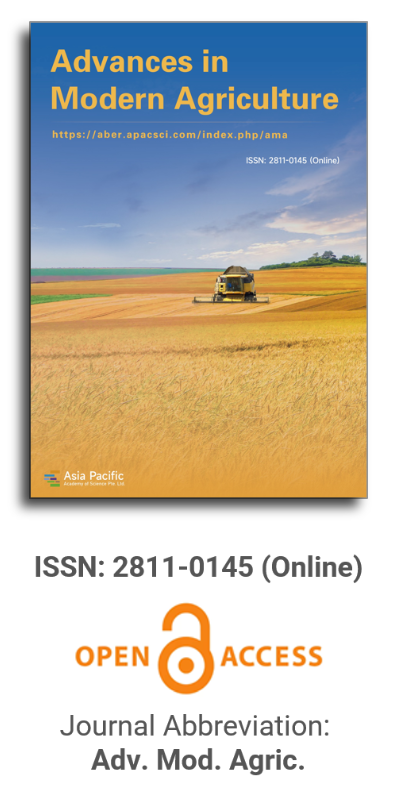


Research on the influence of Internet technology popularization on the green development of agriculture in the Yangtze River Economic Belt
Vol 4, Issue 1, 2023
VIEWS - 6048 (Abstract)
Download PDF
Abstract
Based on the panel data from 2000 to 2018, the super efficiency SBM-DEA model is used to calculate the agricultural green development efficiency of 11 provinces and cities in the Yangtze River economic belt, and then the Tobit econometric model is used to empirically test the impact of Internet technology popularization on the agricultural green development of the Yangtze River economic belt. The results show that: (1) on the whole, the efficiency of agricultural green development in the Yangtze River Economic Belt showed a downward trend in fluctuations from 2000 to 2018; in terms of regions, the efficiency of agricultural green development in various regions of the Yangtze River Economic Belt varies greatly, showing a spatial pattern of “downstream > upstream > midstream”. (2) The popularization of Internet technology has significantly promoted the green development of agriculture in the Yangtze River Economic Belt; at the same time, there is a significant positive correlation between rural human capital and the green development of agriculture in the Yangtze River Economic Belt, while the level of agricultural mechanization, the degree of capital deepening, the level of urbanization, and agricultural economic growth inhibit the improvement of the green development of agriculture in the Yangtze River Economic Belt to a certain extent. Therefore, the local governments of the Yangtze River Economic Belt should actively promote the popularization of Internet technology, enhance the Internet awareness of farmers, and give better play to the enabling role of Internet technology in the green development of agriculture in the Yangtze River Economic Belt.
Keywords
References
- Wang J. Policy interpretation of the “Overall Plan for Ecological and Environmental Big Data Construction” (Chinese). Environmental Protection 2016; 14: 12–14.
- Yu F. Xi Jinping’s new thoughts on green development and the green transformation and development of agriculture (Chinese). China Rural Survey 2016; 5: 2–9.
- Sun W, Wang R, Jiang Q, Huang S. Research on the connotation and evaluation of agricultural green development (Chinese). China Journal of Agricultural Resources and Reginal Planning 2019; 4: 14–21.
- Tu Z, Gan T. Research on regional differences and driving forces of green agricultural development in China (Chinese). Wuhan University Journal (Philosophy & Social Sciences) 2019; 3: 165–178.
- Jin S. Evaluation of inter-provincial agricultural green development levels and regional differences in China (Chinese). Seeker 2019; 2: 89–95.
- Wei Q, Zhang B, Jin S. Construction of China’s agricultural green development index and regional comparative study (Chinese). Issues in Agricultural Economy 2018; 11: 11–20.
- Zhao H, Yu F. Evaluation of agricultural green development level in major grain-producing areas based on entropy value method (Chinese). Reform 2019; 11: 136–146.
- Gong Q, Li X. Construction and measurement of agricultural green development index: 2005–2018 (Chinese). Reform 2020; 1: 133–145.
- Qi Y, Han S, Deng X. Development of green agriculture in China: Production level measurement, spatial differences and convergence analysis (Chinses). Journal of Agrotechnical Economics 2020; 4: 51–65.
- Zheng L, Hong M. Spatiotemporal characteristics and driving factors of agricultural ecological efficiency in China (Chinese). Journal of Jiangxi University of Finance and Economics 2019; 5: 46–56.
- Li M, Bai H. Credit supports research on agricultural green development (Chinese). Research of Agricultural Modernization 2019; 6: 900–906.
- Xue L, Shen Y, Xu C. Agricultural industry agglomeration and agricultural green development: Efficiency measurement and impact (Chinese). Economic Survey 2020; 3: 45–53.
- Wang J. The role of the Internet and its impact on agriculture (Chinese). Rural Economy 2001; 6: 21–22.
- Liu J. “Digital agriculture” and sustainable agricultural development (Chinese). Dongyue Tribune 2010; 2: 70–73.
- Zhang Z, Mao X. “Internet+” reshapes China’s agriculture: Representation, mechanism and essence (Chinese). Reform 2020; 7: 134–144.
- Huang Y, Zhou Z, Huang J. Comparative analysis of regional rural ecological environment governance efficiency based on DEA (Chinese). Journal of Arid Land Resources and Environment 2015; 3: 75–80.
- Tu Z, Gan T, Wang K. Research on the efficiency loss of agricultural subsidy policy based on the perspective of green development (Chinese). Journal of Central China Normal University (Humanities and Social Sciences) 2019; 2: 39–49.
- Fang Y, Zeng X. China’s inter-provincial agricultural ecological efficiency evaluation and analysis of improvement paths (Chinese). Journal of Agricultural Resources and Environment 2021; 1: 135–142.
- Wang B, Zhang W. Inter-provincial differences and influencing factors of China’s agricultural ecological efficiency—based on panel data analysis of 31 provinces from 1996 to 2015 (Chinese). China Rural Economy 2018; 1: 46–62.
- Tone K. A slacks-based measure of efficiency in data envelopment analysis. European Journal of Operational Research 2001; 130(3): 498–509. doi: 10.1016/S0377-2217(99)00407-5
- Li L, Fan D, Kong J. Hubei launches “combination punch” for green agricultural development (Chinese). Available online: http://news.hbtv.com.cn/p/1737311.html (accessed on 27 September 2019).
- Wang Q, Xu Y. Rural areas are surging with new momentum - Zhejiang uses “Internet +” to help rural revitalization (Chinese). Available online: https://zjnews.zjol.com.cn/zjnews/zjxw/201712/t20171202_5892559.shtml (accessed on 2 December 2017).
- Wang W. The “embarrassment” of environmental philosophy: The paradox between technology and environment (Chinese). Journal of Shaanxi Normal University (Philosophy and Social Sciences Edition) 2017; 5: 34–41.
- Pan D. Calculation of China’s agricultural green productivity and analysis of its influencing factors based on the perspective of resource and environmental constraints (Chinese). Statistics & Information Forum 2014; 8: 27–33.
- Tang J, Yin J. Analysis of rural ecological environment problems under the background of urbanization in the past 40 years of reform and opening up (Chinese). Modern Economic Research 2018; 10: 104–109.
Supporting Agencies
Copyright (c) 2023 Xin Yi, Li Cheng

This work is licensed under a Creative Commons Attribution 4.0 International License.

This site is licensed under a Creative Commons Attribution 4.0 International License (CC BY 4.0).

Prof. Zhengjun Qiu
Zhejiang University, China

Cheng Sun
Academician of World Academy of Productivity Science; Executive Chairman, World Confederation of Productivity Science China Chapter, China
Indexing & Archiving
In the realm of modern agriculture, the integration of cutting-edge technologies is revolutionizing the way we approach sustainable farming practices. A recent study published in Advances in Modern Agriculture titled "Classification of cotton water stress using convolutional neural networks and UAV-based RGB imagery" has garnered significant attention for its innovative approach to precision irrigation management. Conducted by researchers from Institute of Data Science and the AgriLife Research and Extension Center of Texas A&M University (authors's information is below). This study introduces a novel method for classifying cotton water stress using unmanned aerial vehicles (UAVs) and convolutional neural networks (CNNs), offering a powerful solution for optimizing water use in agriculture.
Modern agricultural technology is evolving rapidly, with scientists collaborating with leading agricultural enterprises to develop intelligent management practices. These practices utilize advanced systems that provide tailored fertilization and treatment options for large-scale land management.
This journal values human initiative and intelligence, and the employment of AI technologies to write papers that replace the human mind is expressly prohibited. When there is a suspicious submission that uses AI tools to quickly piece together and generate research results, the editorial board of the journal will reject the article, and all journals under the publisher's umbrella will prohibit all authors from submitting their articles.
Readers and authors are asked to exercise caution and strictly adhere to the journal's policy regarding the usage of Artificial Intelligence Generated Content (AIGC) tools.
Asia Pacific Academy of Science Pte. Ltd. (APACSCI) specializes in international journal publishing. APACSCI adopts the open access publishing model and provides an important communication bridge for academic groups whose interest fields include engineering, technology, medicine, computer, mathematics, agriculture and forestry, and environment.



.jpg)
.jpg)

.jpg)
